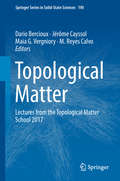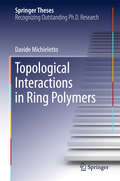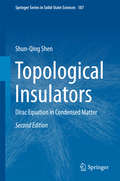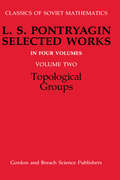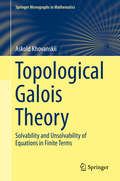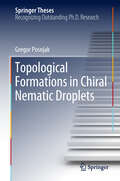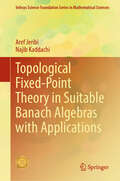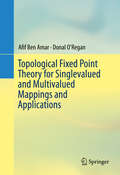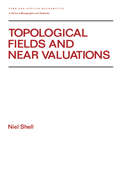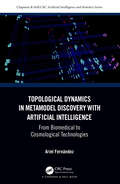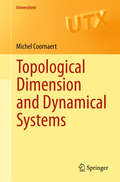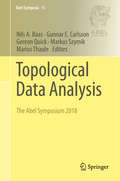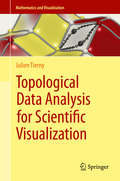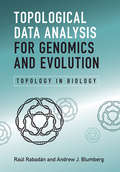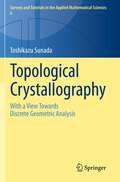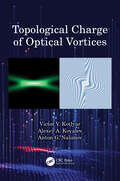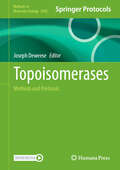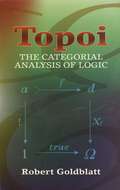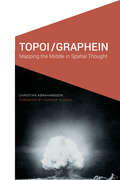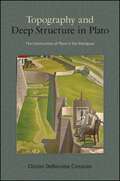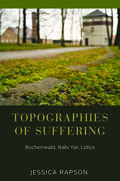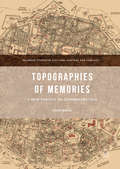- Table View
- List View
Topological Matter: Lectures From The Topological Matter School 2017 (Springer Series In Solid-state Sciences Ser. #190)
by Dario Bercioux Jérôme Cayssol Maia G. Vergniory M. Reyes CalvoThis book covers basic and advanced aspects in the field of Topological Matter. The chapters are based on the lectures presented during the Topological Matter School 2017. It provides graduate level content introducing the basic concepts of the field, including an introductory session on group theory and topological classification of matter. Different topological phases such as Weyls semi-metals, Majoranas fermions and topological superconductivity are also covered. A review chapter on the major experimental achievements in the field is also provided. The book is suitable not only for master, graduate and young postdoctoral researchers, but also to senior scientists who want to acquaint themselves with the subject.
Topological Interactions in Ring Polymers
by Davide MichielettoRing polymers are one of the last big mysteries in polymer physics, and this thesis tackles the problem of describing their behaviour when interacting in dense solutions and with complex environments and reports key findings that help shed light on these complex issues. The systems investigated are not restricted to artificial polymer systems, but also cover biologically inspired ensembles, contributing to the broad applicability and interest of the conclusions reached. One of the most remarkable findings is the unambiguous evidence that rings inter-penetrate when in dense solutions; here this behaviour is shown to lead to the emergence of a glassy state solely driven by the topology of the constituents. This novel glassy state is unconventional in its nature and, thanks to its universal properties inherited from polymer physics, will attract the attention of a wide range of physicists in the years to come.
Topological Insulators: Dirac Equation in Condensed Matters
by Shun-Qing ShenTopological insulators are insulating in the bulk, but process metallic states present around its boundary owing to the topological origin of the band structure. The metallic edge or surface states are immune to weak disorder or impurities, and robust against the deformation of the system geometry. This book, the first of its kind on topological insulators, presents a unified description of topological insulators from one to three dimensions based on the modified Dirac equation. A series of solutions of the bound states near the boundary are derived, and the existing conditions of these solutions are described. Topological invariants and their applications to a variety of systems from one-dimensional polyacetalene, to two-dimensional quantum spin Hall effect and p-wave superconductors, and three-dimensional topological insulators and superconductors or superfluids are introduced, helping readers to better understand this fascinating new field. This book is intended for researchers and graduate students working in the field of topological insulators and related areas. Shun-Qing Shen is a Professor at the Department of Physics, the University of Hong Kong, China.
Topological Insulators
by Shun-Qing ShenTopological insulators are insulating in the bulk, but process metallic states present around its boundary owing to the topological origin of the band structure. The metallic edge or surface states are immune to weak disorder or impurities, and robust against the deformation of the system geometry. This book, the first of its kind on topological insulators, presents a unified description of topological insulators from one to three dimensions based on the modified Dirac equation. A series of solutions of the bound states near the boundary are derived, and the existing conditions of these solutions are described. Topological invariants and their applications to a variety of systems from one-dimensional polyacetalene, to two-dimensional quantum spin Hall effect and p-wave superconductors, and three-dimensional topological insulators and superconductors or superfluids are introduced, helping readers to better understand this fascinating new field. This book is intended for researchers and graduate students working in the field of topological insulators and related areas. Shun-Qing Shen is a Professor at the Department of Physics, the University of Hong Kong, China.
Topological Indices and Related Descriptors in QSAR and QSPR
by James Devillers Alexandru T. BalabanTopological Indices and Related Descriptors in QSAR and QSPR reviews the state of the art in this field and highlights the important advances in the generation of descriptors calculated directly from the structure of molecules. This long-awaited comprehensive book provides all the necessary information to calculate and use these descriptors for deriving structure-activity and structure-property relationships. Written by leading experts in the field, this book discusses the physicochemical significance, strengths, and weaknesses of these indices and presents numerous examples of applications. This book will be a valuable reference for anyone involved in the use of QSAR and QSPR in the pharmaceutical, applied chemical, and environmental sciences. It is also suitable for use as a supplementary textbook on related graduate level courses.
Topological Groups
by R.V. GamkrelidzeOffering the insights of L.S. Pontryagin, one of the foremost thinkers in modern mathematics, the second volume in this four-volume set examines the nature and processes that make up topological groups. Already hailed as the leading work in this subject for its abundance of examples and its thorough explanations, the text is arranged so that readers can follow the material either sequentially or schematically. Stand-alone chapters cover such topics as topological division rings, linear representations of compact topological groups, and the concept of a lie group.
Topological Galois Theory
by Askold KhovanskiiThis book provides a detailed and largely self-contained description of various classical and new results on solvability and unsolvability of equations in explicit form. In particular, it offers a complete exposition of the relatively new area of topological Galois theory, initiated by the author. Applications of Galois theory to solvability of algebraic equations by radicals, basics of Picard-Vessiot theory, and Liouville's results on the class of functions representable by quadratures are also discussed. A unique feature of this book is that recent results are presented in the same elementary manner as classical Galois theory, which will make the book useful and interesting to readers with varied backgrounds in mathematics, from undergraduate students to researchers. In this English-language edition, extra material has been added (Appendices A-D), the last two of which were written jointly with Yura Burda.
Topological Formations in Chiral Nematic Droplets (Springer Theses)
by Gregor PosnjakIn this book Gregor Posnjak unravels the long-standing mystery of the internal director structure of chiral nematic droplets, which has been studied both experimentally and theoretically since the 1970s. To do so, he develops a new method for the reconstruction of director fields from a set of fluorescent confocal polarising microscopy images, which he augments with a simulated annealing algorithm. This allows the full reconstruction of 3D director fields, describing the ordering of the liquid crystal. The reconstruction procedure and its principles, which are applicable to other methods of studying vector fields, are explained in detail. The method is subsequently used to explore complex 3D structures in chiral nematic liquid crystal droplets with perpendicular surface anchoring. Twentyfour distinct states are identified and presented, including the layered structures of different symmetries and states with multiple topological point defects, separated by localized chiral structures. In closing, the book reports on the first observation of topological point defects with higher topological charges q = −2 and q = −3.
Topological Fixed-Point Theory in Suitable Banach Algebras with Applications (Infosys Science Foundation Series)
by Aref Jeribi Najib KaddachiThis book delves into the topics of fixed-point theory as applied to block operator matrices within the context of Banach algebras featuring multi-valued inputs. Its scope extends to a broad range of equations, encompassing nonlinear biological models as well as two-dimensional boundary value problems associated with burgeoning cell populations and functional systems of differential and integral inclusions. The book systematically introduces the principles of topological fixed-point theory, offering insights into various classes of both single-valued and multi-valued maps. The overarching goal is to disseminate key techniques and outcomes derived from fixed-point theory, with a specific emphasis on its application to both single-valued and multi-valued mappings within the framework of Banach algebras.
Topological Fixed Point Theory for Singlevalued and Multivalued Mappings and Applications
by Afif Ben Amar Donal O'ReganThis is a monograph covering topological fixed point theory for several classes of single and multivalued maps. The authors begin by presenting basic notions in locally convex topological vector spaces. Special attention is then devoted to weak compactness, in particular to the theorems of Eberlein-Smulian, Grothendick and Dunford-Pettis. Leray-Schauder alternatives and eigenvalue problems for decomposable single-valued nonlinear weakly compact operators in Dunford-Pettis spaces are considered, in addition to some variants of Schauder, Krasnoselskii, Sadovskii, and Leray-Schauder type fixed point theorems for different classes of weakly sequentially continuous operators on general Banach spaces. The authors then proceed with an examination of Sadovskii, Furi-Pera, and Krasnoselskii fixed point theorems and nonlinear Leray-Schauder alternatives in the framework of weak topologies and involving multivalued mappings with weakly sequentially closed graph. These results are formulated in terms of axiomatic measures of weak noncompactness. The authors continue to present some fixed point theorems in a nonempty closed convex of any Banach algebras or Banach algebras satisfying a sequential condition (P) for the sum and the product of nonlinear weakly sequentially continuous operators, and illustrate the theory by considering functional integral and partial differential equations. The existence of fixed points, nonlinear Leray-Schauder alternatives for different classes of nonlinear (ws)-compact operators (weakly condensing, 1-set weakly contractive, strictly quasi-bounded) defined on an unbounded closed convex subset of a Banach space are also discussed. The authors also examine the existence of nonlinear eigenvalues and eigenvectors, as well as the surjectivity of quasibounded operators. Finally, some approximate fixed point theorems for multivalued mappings defined on Banach spaces. Weak and strong topologies play a role here and both bounded and unbounded regions are considered. The authors explicate a method developed to indicate how to use approximate fixed point theorems to prove the existence of approximate Nash equilibria for non-cooperative games. Fixed point theory is a powerful and fruitful tool in modern mathematics and may be considered as a core subject in nonlinear analysis. In the last 50 years, fixed point theory has been a flourishing area of research. As such, the monograph begins with an overview of these developments before gravitating towards topics selected to reflect the particular interests of the authors.
Topological Fields and Near Valuations
by Niel ShellPart I (eleven chapters) of this text for graduate students provides a Survey of topological fields, while Part II (five chapters) provides a relatively more idiosyncratic account of valuation theory.
Topological Dynamics in Metamodel Discovery with Artificial Intelligence: From Biomedical to Cosmological Technologies (Chapman & Hall/CRC Artificial Intelligence and Robotics Series)
by Ariel FernándezThe leveraging of artificial intelligence (AI) for model discovery in dynamical systems is cross-fertilizing and revolutionizing both disciplines, heralding a new era of data-driven science. This book is placed at the forefront of this endeavor, taking model discovery to the next level. Dealing with artificial intelligence, this book delineates AI’s role in model discovery for dynamical systems. With the implementation of topological methods to construct metamodels, it engages with levels of complexity and multiscale hierarchies hitherto considered off limits for data science. Key Features: Introduces new and advanced methods of model discovery for time series data using artificial intelligence Implements topological approaches to distill "machine-intuitive" models from complex dynamics data Introduces a new paradigm for a parsimonious model of a dynamical system without resorting to differential equations Heralds a new era in data-driven science and engineering based on the operational concept of "computational intuition" Intended for graduate students, researchers, and practitioners interested in dynamical systems empowered by AI or machine learning and in their biological, engineering, and biomedical applications, this book will represent a significant educational resource for people engaged in AI-related cross-disciplinary projects.
Topological Dimension and Dynamical Systems
by Michel CoornaertTranslated from the popular French edition, the goal of the book is to provide a self-contained introduction to mean topological dimension, an invariant of dynamical systems introduced in 1999 by Misha Gromov. The book examines how this invariant was successfully used by Elon Lindenstrauss and Benjamin Weiss to answer a long-standing open question about embeddings of minimal dynamical systems into shifts. A large number of revisions and additions have been made to the original text. Chapter 5 contains an entirely new section devoted to the Sorgenfrey line. Two chapters have also been added: Chapter 9 on amenable groups and Chapter 10 on mean topological dimension for continuous actions of countable amenable groups. These new chapters contain material that have never before appeared in textbook form. The chapter on amenable groups is based on Følner's characterization of amenability and may be read independently from the rest of the book. Although the contents of this book lead directly to several active areas of current research in mathematics and mathematical physics, the prerequisites needed for reading it remain modest; essentially some familiarities with undergraduate point-set topology and, in order to access the final two chapters, some acquaintance with basic notions in group theory. Topological Dimension and Dynamical Systems is intended for graduate students, as well as researchers interested in topology and dynamical systems. Some of the topics treated in the book directly lead to research areas that remain to be explored.
Topological Degree Theory and Applications (Mathematical Analysis and Applications)
by Yeol Je Cho Yu-Qing ChenSince the 1960s, many researchers have extended topological degree theory to various non-compact type nonlinear mappings, and it has become a valuable tool in nonlinear analysis. Presenting a survey of advances made in generalizations of degree theory during the past decade, this book focuses on topological degree theory in normed spaces and its ap
Topological Data Analysis: The Abel Symposium 2018 (Abel Symposia #15)
by Markus Szymik Nils A. Baas Gunnar E. Carlsson Gereon Quick Marius ThauleThis book gathers the proceedings of the 2018 Abel Symposium, which was held in Geiranger, Norway, on June 4-8, 2018. The symposium offered an overview of the emerging field of "Topological Data Analysis". This volume presents papers on various research directions, notably including applications in neuroscience, materials science, cancer biology, and immune response. Providing an essential snapshot of the status quo, it represents a valuable asset for practitioners and those considering entering the field.
Topological Data Analysis for Scientific Visualization
by Julien TiernyCombining theoretical and practical aspects of topology, this book provides a comprehensive and self-contained introduction to topological methods for the analysis and visualization of scientific data. Theoretical concepts are presented in a painstaking but intuitive manner, with numerous high-quality color illustrations. Key algorithms for the computation and simplification of topological data representations are described in detail, and their application is carefully demonstrated in a chapter dedicated to concrete use cases. With its fine balance between theory and practice, "Topological Data Analysis for Scientific Visualization" constitutes an appealing introduction to the increasingly important topic of topological data analysis for lecturers, students and researchers.
Topological Data Analysis for Genomics and Evolution: Topology in Biology
by Raúl Rabadán Andrew J. BlumbergBiology has entered the age of Big Data. The technical revolution has transformed the field, and extracting meaningful information from large biological data sets is now a central methodological challenge. Algebraic topology is a well-established branch of pure mathematics that studies qualitative descriptors of the shape of geometric objects. It aims to reduce questions to a comparison of algebraic invariants, such as numbers, which are typically easier to solve. Topological data analysis is a rapidly-developing subfield that leverages the tools of algebraic topology to provide robust multiscale analysis of data sets. This book introduces the central ideas and techniques of topological data analysis and its specific applications to biology, including the evolution of viruses, bacteria and humans, genomics of cancer and single cell characterization of developmental processes. Bridging two disciplines, the book is for researchers and graduate students in genomics and evolutionary biology alongside mathematicians interested in applied topology.
Topological Crystallography
by Toshikazu SunadaGeometry in ancient Greece is said to have originated in the curiosity of mathematicians about the shapes of crystals, with that curiosity culminating in the classification of regular convex polyhedra addressed in the final volume of Euclid's Elements. Since then, geometry has taken its own path and the study of crystals has not been a central theme in mathematics, with the exception of Kepler's work on snowflakes. Only in the nineteenth century did mathematics begin to play a role in crystallography as group theory came to be applied to the morphology of crystals. This monograph follows the Greek tradition in seeking beautiful shapes such as regular convex polyhedra. The primary aim is to convey to the reader how algebraic topology is effectively used to explore the rich world of crystal structures. Graph theory, homology theory, and the theory of covering maps are employed to introduce the notion of the topological crystal which retains, in the abstract, all the information on the connectivity of atoms in the crystal. For that reason the title Topological Crystallography has been chosen. Topological crystals can be described as "living in the logical world, not in space," leading to the question of how to place or realize them "canonically" in space. Proposed here is the notion of standard realizations of topological crystals in space, including as typical examples the crystal structures of diamond and lonsdaleite. A mathematical view of the standard realizations is also provided by relating them to asymptotic behaviors of random walks and harmonic maps. Furthermore, it can be seen that a discrete analogue of algebraic geometry is linked to the standard realizations. Applications of the discussions in this volume include not only a systematic enumeration of crystal structures, an area of considerable scientific interest for many years, but also the architectural design of lightweight rigid structures. The reader therefore can see the agreement of theory and practice.
Topological Charge of Optical Vortices
by Victor V. Kotlyar Alexey A. Kovalev Anton G. NalimovThis book is devoted to the consideration of unusual laser beams – vortex or singular beams. It contains many numerical examples, which clearly show how the phase of optical vortices changes during propagation in free space, and that the topological charge is preserved.Topological Charge of Optical Vortices shows that the topological charge of an optical vortex is equal to the number of screw dislocations or the number of phase singularities in the beam cross-section. A single approach is used for the entire book: based on M. Berry’s formula. It is shown that phase singularities during beam propagation can be displaced to infinity at a speed greater than the speed of light. The uniqueness of the book is that the calculation of the topological charge for scalar light fields is extended to vector fields and is used to calculate the Poincare–Hopf singularity index for vector fields with inhomogeneous linear polarization with V-points and for the singularity index of vector fields with inhomogeneous elliptical polarization with C-points and C- lines. The book is written for opticians, and graduate students interested in an interesting section of optics – singular optics. It will also be of interest to scientists and researchers who are interested in modern optics. In order to understand the content of the book, it is enough to know paraxial optics (Fourier optics) and be able to calculate integrals.
Topoisomerases: Methods and Protocols (Methods in Molecular Biology #2928)
by Joseph DeweeseThis volume is intended to provide both fundamental methods for long-standing assays as well as recent advances in the field toward newer pathways. Chapters guide readers through methods tailored to studying prokaryotic topoisomerases including fundamental protocols for purification and basic characterization of prokaryotic enzymes, enzymology examining DNA cleavage, relaxation, decatenation, and binding to more complex assays dissecting cellular function and interactions, and bioinformatics protocol for examining protein sequence interdependencies with application across many different proteins beyond topoisomerases. Authoritative and cutting-edge, Topoisomerases: Methods and Protocols as a resource both to new investigators and to long-standing researchers in the field of topoisomerases.
Topoi: The Categorial Analysis of Logic
by Robert GoldblattA classic introduction to mathematical logic from the perspective of category theory, this text is suitable for advanced undergraduates and graduate students and accessible to both philosophically and mathematically oriented readers. Its approach moves always from the particular to the general, following through the steps of the abstraction process until the abstract concept emerges naturally.Beginning with a survey of set theory and its role in mathematics, the text proceeds to definitions and examples of categories and explains the use of arrows in place of set-membership. The introduction to topos structure covers topos logic, algebra of subobjects, and intuitionism and its logic, advancing to the concept of functors, set concepts and validity, and elementary truth. Explorations of categorial set theory, local truth, and adjointness and quantifiers conclude with a study of logical geometry.
Topoi/Graphein: Mapping the Middle in Spatial Thought (Cultural Geographies + Rewriting the Earth)
by Christian Abrahamsson Gunnar OlssonIn Topoi/Graphein Christian Abrahamsson maps the paradoxical limit of the in-between to reveal that to be human is to know how to live with the difference between the known and the unknown. Using filmic case studies, including Code Inconnu, Lord of the Flies, and Apocalypse Now, and focusing on key concerns developed in the works of the philosophers Deleuze, Olsson, and Wittgenstein, Abrahamsson starts within the notion of fixed spatiality, in which human thought and action are anchored in the given of identity. He then moves through a social world in which spatiotemporal transformations are neither fixed nor taken for granted. Finally he edges into the pure temporality that lies beyond the maps of fixed points and social relations. Each chapter is organized into two subjects: topoi, or excerpts from the films, and graphein, the author’s interpretation of presented theories to mirror the displacements, transpositions, juxtapositions, fluctuations, and transformations between delimited categories. A landmark work in the study of human geography, Abrahamsson’s book proposes that academic and intellectual attention should focus on the spatialization between meaning and its materialization in everyday life.
Topography and Deep Structure in Plato: The Construction of Place in the Dialogues (SUNY series in Ancient Greek Philosophy)
by Clinton DeBevoise CorcoranIn this book, Clinton DeBevoise Corcoran examines the use of place in Plato's dialogues. Corcoran argues that spatial representations, such as walls, caves, and roads, as well as the creation of eternal patterns and chaotic images in the particular spaces, times, characterizations, and actions of the dialogues, provide clues to Plato's philosophic project. Throughout the dialogues, the Good serves as an overarching ordering principle for the construction of place and the proper limit of spaces, whether they be here in the world, deep in the underworld, or in the nonspatial ideal realm of the Forms. The Good, since it escapes the limits of space and time, equips Plato with a powerful mythopoetic tool to create settings, frames, and arguments that superimpose different dimensions of reality, allowing worlds to overlap that would otherwise be incommensurable. The Good also serves as a powerful ethical tool for evaluating the order of different spaces. Corcoran explores how Plato uses wrestling and war as metaphors for the mixing of the nonspatial, eternal forms in the world and history, and how he uses spatial images throughout the dialogues to critique Athens's tragic overreach in the Peloponnesian War. Far from merely an incidental backdrop in the dialogues, place etches the tragic intersection of the mortal and the immortal, good and evil, and Athens's past, present, and future.
Topographies of Suffering: Buchenwald, Babi Yar, Lidice
by Jessica RapsonCommentary on memorials to the Holocaust has been plagued with a sense of "monument fatigue", a feeling that landscape settings and national spaces provide little opportunity for meaningful engagement between present visitors and past victims. This book examines the Holocaust via three sites of murder by the Nazis: the former concentration camp at Buchenwald, Germany; the mass grave at Babi Yar, Ukraine; and the razed village of Lidice, Czech Republic. Bringing together recent scholarship from cultural memory and cultural geography, the author focuses on the way these violent histories are remembered, allowing these sites to emerge as dynamic transcultural landscapes of encounter in which difficult pasts can be represented and comprehended in the present. This leads to an examination of the role of the environment, or, more particularly, the ways in which the natural environment, co-opted in the process of killing, becomes a medium for remembrance.
Topographies of Memories
by Anita BakshiThis book explores new approaches towards developing memorial and heritage sites, moving beyond the critique of existing practices that have been the traditional focus of studies of commemoration. Offering understandings of the effects of conflict on memories of place, as manifested in everyday lives and official histories, it explores the formation of urban identities and constructed images of the city. Topographies of Memories suggests interdisciplinary approaches for creating commemorative sites with shared stakes. The first part of the book focuses on memory dynamics, the second on Nicosia, the divided capital of Cyprus, and the third on physical and material world interventions. Design practices and modes of engagement with places of memory are explored, making connections between theoretical explorations of memory and forgetting and practical strategies for designers and practitioners.
